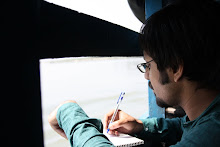
Although largely unnoticed by the mainstream media, last Sunday bass genius Jonas Hellborg and Carnatic percussionist V Selvaganesh performed an intimate and brilliant set at Tabula Rasa at Delhi’s Square One mall. While the venue was quite a disaster and the audience largely intent on socializing than listening to the duo, the musicians themselves didn’t disappoint. Laying down impossibly funky grooves and improvising freely on a semi-acoustic bass and the kanjira, the performance went a long way to show just how much can be accomplished by widening the melodic scope of what was essentially the rhythm section. Coming at the end of a month long six-city tour, by the time Selvaganesh and Hellborg performed here they were firing on all cylinders and were clearly reveling in each other’s musical company. This isn’t of any real surprise if you consider the fact that the two have been playing together as a part of various ensembles for more than a decade now.
But before I get to the meat of the performance in another post, I want to talk about a concert DVD that I watched Sunday afternoon as a sort of preparatory exercise before seeing the two musicians. The DVD in question is Paris, documenting the first show of a tour that Hellborg undertook in 2001 with the late guitarist Shawn Lane, Selvaganesh, ghatak player Umashankar and Carnatic Classical vocalist Umamahesh. Being primarily a rock kid with an affection for three minute pop songs I approach fusion music with a degree of cynicism and suspicion, but sitting through the concert- in which the shortest song clocks in at nine and a half minutes, and the longest at a little over twenty minutes- was a mesmerizing experience. Both Hellborg and Lane are highly respected fusion musicians in their respective instruments, but they definitely deserve greater renown. Especially Hellborg. Going by what he played, I’m inclined to believe all the talk of Hellborg being the biggest jaw-dropping player of the four-stringed instrument. Moonlighting at various stages of their career as heavy metal stylists, both Lane and Hellborg do not shy away from rhythmic ferocity, but never at the cost of sheer musicality and taste. Indeed, Lane has the chops and the speed to put most virtuosos to shame, and he does so effortlessly, grimacing with concentration and occasionally smiling like a happy bear. Through it all, he chain smokes. Using effects to double track his guitar lines, a strange sound emerges. Not only does it seem that there are two guitars playing, sometimes it seems as if the guitar is dueling with a Carnatic violin. Hellborg, the leader of the group, revels in his role of being the funky backbone to the music, and the times that he breaks out in little bursts of whirlwind legato playing its fascinating to watch. For those who think of the bass as a cumbersome instrument, look at Hellborg’s playing for effortless dexterity. Again, his contribution to the sound is totally musical.
Which brings us to the three Indian musicians, who are, actually brothers. Selvaganesh and his Kanjira (a smaller version of the dafli) are the best known of the three, and the range of sounds that he generates with his complex polyrythms is breathtaking. Not only does it occasionally thunder like a rock drum, it includes passages of such delicacy, that you have to hear it to believe it. A much more subdued sonic presence is that of his brother Umamahesh. The sound of the ghatak, though is unmistakable, and the brothers, in tandem with Hellborg, create a intricate and powerful rhythm section. As opposed to purist Indian classical music, Hellborg’s bass gives the sound a heavy bottom, which thankfully, sounds completely integrated with the music. The percussionists delight in their scatty conversation in Leal Souvenir. Over all this glides Lane’s fantastic guitar. Exquisite music, if a tad overlong.



